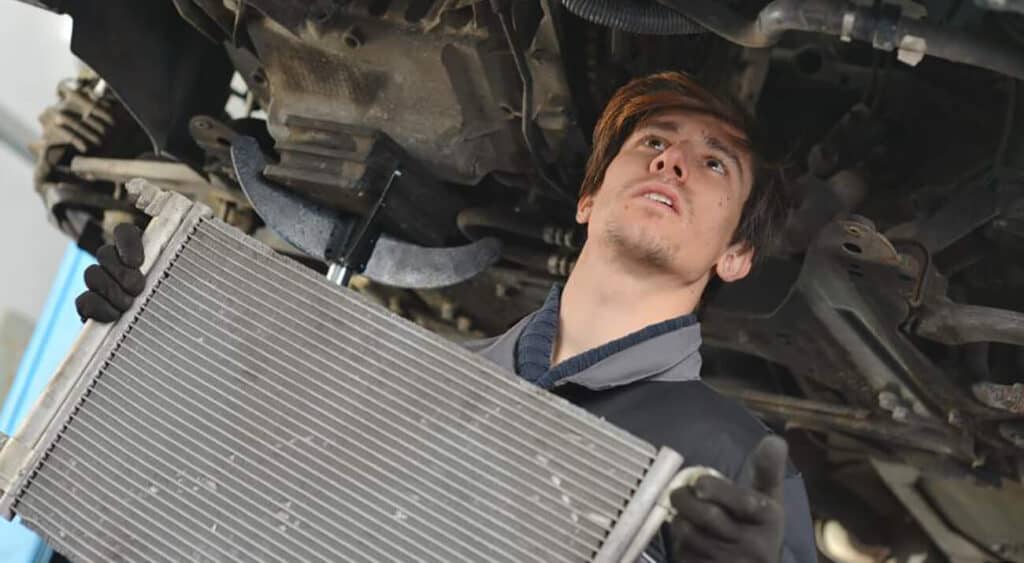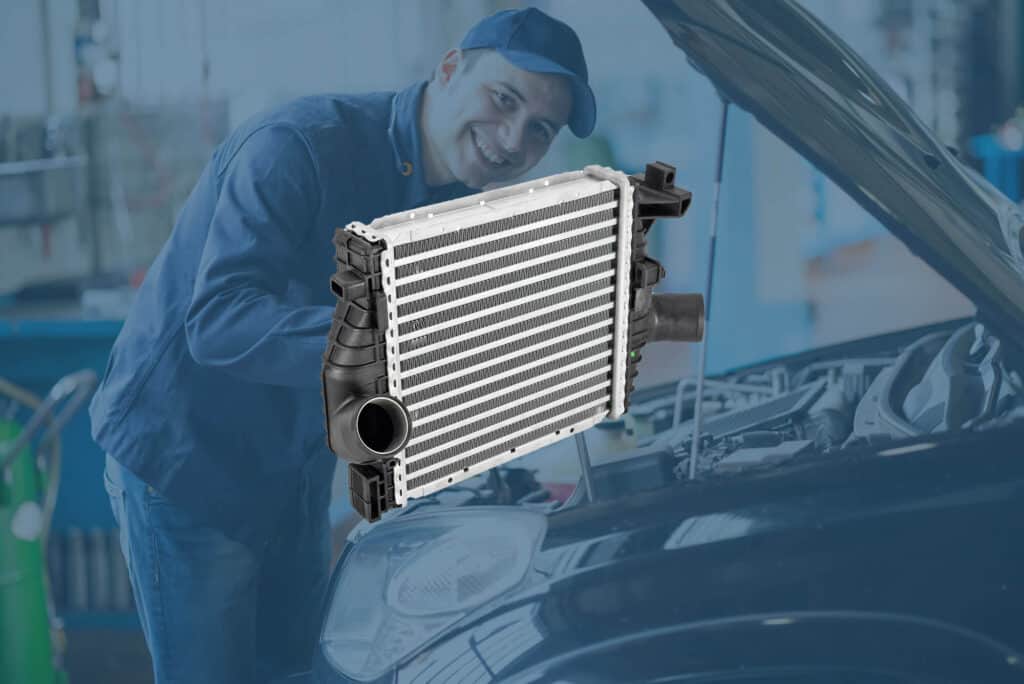Getting Started: Understanding Your Radiator’s Basics
The radiator, while often unheralded, is the unsung hero of your vehicle’s cooling system. It dissipates heat, ensuring your engine doesn’t transform into a miniature sun. Simplistically, it’s a series of tubes and fins, facilitating the transfer of heat from the coolant to the air blown by the fan.
The DIY Enthusiast’s Guide: Simple Radiator Maintenance
For those with an intrinsic knack for hands-on vehicle care, knowing the basics can be the difference between a quick fix and a call to the mechanic. Let’s delve into some of these do-it-yourself tasks that can help extend the life of your radiator and possibly save you a pretty penny:
Checking Coolant Levels: The Elixir of Life for Your Engine
• Visibility Check: Open the car’s hood and locate the translucent coolant reservoir. It usually has markings indicating ‘MIN’ and ‘MAX’ levels.
• Consistency & Color: The coolant should have a consistent color, free from dirt or debris. Often, it’s either bright green, orange, or pink, but this can vary by brand and vehicle type.
• When to Refill: If the coolant level is closer to the ‘MIN’ mark, it might be time for a top-up. Always use the recommended coolant type for your vehicle, which can be found in the owner’s manual.
• Safety Note: Never open the radiator cap when the engine is hot! The coolant inside is under pressure and can cause severe burns.

Cleaning the Radiator: Ensuring Unhindered Airflow
• Visual Inspection: With the engine off and cooled, inspect the front of the radiator for leaves, trash, or other debris that might obstruct airflow.
• Hosing Down: Using a garden hose with a nozzle, gently spray water through the radiator’s front grille to remove loose debris. For stubborn dirt, a soft brush can be useful.
• Backside Check: Sometimes, debris can get lodged behind the radiator. If accessible, give that area a gentle cleaning as well.
• Drying Off: While it’s okay to let the radiator air dry, using a soft cloth can speed up the process and prevent water spots.
Spotting Minor Leaks: Your Vehicle’s Cry for Attention
• Puddles and Spots: Notice any greenish or orangish liquid underneath your car? That’s possibly coolant.
Smell Test: A sweet, syrupy odor when the engine is running can also indicate a coolant leak.
• Consistency Check: Coolant has a slightly slimy feel, distinguishing it from water or other vehicle fluids.
• Hose & Clamp Inspection: Check the radiator hoses and clamps for signs of wear, corrosion, or damage. These are common sites for minor leaks.
• Sealants & Fixes: If you identify a small leak, radiator sealants available in automotive stores might offer a temporary fix. However, always consult your vehicle’s manual or a professional before using them.
Watch Out! Recognizing Symptoms Beyond DIY Repair
While basic maintenance might be within the grasp of most car owners, some radiator symptoms are red flags indicating the need for professional intervention. If you notice any of the following, it’s time to call in the cavalry:
• Persistent Overheating: If your car’s temperature gauge frequently veers into the red zone, especially during short drives, it’s an unmistakable cry for help.
• Murky Coolant: A healthy coolant should be relatively translucent and brightly colored. If yours resembles dirty pond water, it’s indicative of contaminants or rust, hinting at deeper issues.
• Unsettling Noises: Should you hear a rhythmic knocking or tapping sound emanating from the front of your vehicle, it’s more than just an annoying beat. It might be a telltale sign of radiator or engine trouble.
These issues, while appearing on the surface, might be the proverbial tip of the iceberg, suggesting more severe underlying problems.
The Cost of Waiting: Potential Dangers of Delayed Repairs
When it comes to your vehicle’s radiator, procrastination can be a costly mistake, both in terms of vehicle health and overall safety. The age-old saying, “A stitch in time saves nine,” couldn’t be more apt. By brushing off those initial warning signs or pushing that mechanic visit to some distant future date, you’re potentially opening the door for a domino effect of complications.
Firstly, let’s talk about the warped cylinder heads. These are pivotal components in your vehicle’s engine. When a radiator malfunctions, the engine is deprived of its essential cooling function. Persistent overheating can lead to the warping of these cylinder heads. This warping isn’t just a minor hiccup; it’s a significant disruption that can diminish engine performance and lead to costly replacements.
Then there’s the dreaded blown head gasket. This component acts as a seal between the engine block and the cylinder head. Overheating, often a result of radiator neglect, can cause this gasket to fail. When this happens, coolant might enter the engine’s combustion chambers. This not only reduces the engine’s efficiency but also risks severe damage.
Lastly, the heater core, a smaller cousin of the radiator, can also face repercussions. Responsible for warming the air that enters your vehicle’s cabin, a compromised heater core means those chilly winter rides just got colder. Moreover, a malfunctioning heater core can lead to fogged-up windows, making driving hazardous.
In essence, the cascade of complications stemming from a neglected radiator can rapidly spiral out of control. These aren’t just threats to your vehicle’s health but also pose risks to your safety and can deliver a hefty blow to your wallet.
Mobile Mechanics to the Rescue: Benefits of On-The-Go Professional Help
The traditional image of auto repair—a greasy garage, long wait times, and an incessant cacophony of clanging tools—is getting a modern makeover, thanks to mobile mechanics. Here’s why many are hopping on this trend:
• Convenience: Gone are the days of towing your malfunctioning vehicle to a workshop. Mobile mechanics come to you, be it your home, office, or even a random roadside.
• Expertise on Wheels: These mechanics aren’t just regular technicians; they’re seasoned pros equipped with specialized knowledge, now available at your beck and call.
• Transparent Pricing: Without the operational costs associated with traditional garages, many mobile mechanics can offer competitive, clear-cut pricing, ensuring you get value for your money.

Diving Deeper: Understanding When Professional Diagnosis is Key
While the idea of DIY might appeal to many, there are specific radiator troubles that are better left to the experts. These include:
• Complex Leaks: Sure, spotting a leak from the reservoir or hoses is straightforward. But identifying one within the intricate channels of the radiator? That’s a task best suited for seasoned eyes.
• Thermostat Troubles: This seemingly inconspicuous component has a critical job—regulating the flow of coolant to ensure optimal engine temperature. If it goes haywire, the ramifications can be extensive.
• Advanced Repairs: Certain issues, such as replacing the radiator core or addressing complicated malfunctions, are beyond standard DIY guides. They demand professional expertise and specialized tools.
In essence, while taking the initiative for basic maintenance is commendable, recognizing when to step back and let professionals take the lead is equally crucial.
The Investment Perspective: Weighing Costs of DIY vs. Professional Repairs
To the DIY enthusiast, rolling up one’s sleeves and diving into a radiator repair might appear as both a challenge and a cost-saving venture. While the initial costs of DIY repairs might seem minimal—buying a replacement part here, a tool there—the real expenses often lurk in the shadows.
For starters, there’s the cost of tools. A one-time fix might require specialized tools that you don’t currently own. While you might rationalize it as a long-term investment, consider how frequently you’ll actually use that specific tool in the future. The chances are, not very often.
Then there’s the cost of parts. While many turn to online tutorials and forums for guidance, selecting the right quality and compatible parts for your vehicle’s make and model isn’t always straightforward. An incorrect or subpar part might end up causing more harm than good, leading to further replacements and costs.
Time, as they say, is money. The hours spent trying to troubleshoot, understand, and implement a fix can be extensive. For those not well-versed in car mechanics, what seems like a simple task might end up consuming an entire weekend.
But perhaps the most significant hidden cost is the risk of exacerbating the problem. A misstep, an incorrect installation, or even a momentary lapse in judgment can turn a minor issue into a major one. In these scenarios, the cost of professional repairs can skyrocket, often exceeding what it would have been if sought initially.
Navigating the Road Ahead with Confidence
Balancing the allure of DIY with the wisdom of knowing when to seek expert guidance ensures your radiator serves you reliably. For those moments of doubt, remember there are mobile mechanics like Uchanics ready to assist, offering a blend of convenience and expertise to ensure your drive remains smooth and cool. Safe journeys!
